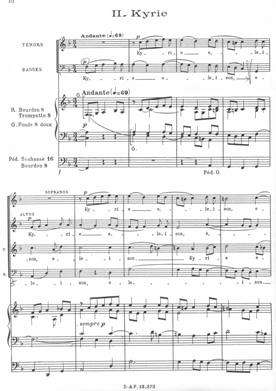Requiem (Duruflé)

The Requiem, Op. 9, by Maurice Duruflé was published in 1947 by the French music publisher Durand. Commissioned in 1941 by the collaborationist Vichy regime,[1] Duruflé was still working on the piece at the time of the regime's collapse in 1944, and completed it in 1947, dedicating it to the memory of his father. The work is for SATB choir with mezzo-soprano and baritone soloists. It exists in three orchestrations: one for organ alone, one for organ with string orchestra and optional trumpets, harp and timpani, and one for organ and full orchestra.
At the time of commission, Duruflé was working on an organ suite using themes from Gregorian chants. He incorporated his sketches for that work into the Requiem, which uses numerous themes from the Gregorian "Mass for the Dead."[2] Nearly all the thematic material in the work comes from chant.
Structure
The work is set in nine movements. Like many requiems, Duruflé's omits the Gradual and the Tract. The Dies irae text, perhaps the most famous portion of the Requiem Mass, is not set. Duruflé's omission of this text and inclusion of others (Pie Jesu, Libera me, In Paradisum, from the burial service, mirroring Fauré), makes the composition calmer and more meditative than some other settings. In the full score, the fifth movement, Pie Jesu, has the only solo for the mezzo-soprano; in addition, even in the "organ-only" version of the Requiem, there is an obbligato cello solo. The baritone soloist has parts in the third movement, Domine Jesu Christe, and the penultimate movement, Libera me. Duruflé left indications in the score that, for the baritone soloist at least, it was preferable to have the choir sing the solos instead. This has resulted in various forces being used in different performances, some with both soloists, some with only the mezzo-soprano, and some (such as Robert Shaw's Telarc recording) using no soloists at all.
- Introit (Requiem Aeternam)
- Kyrie eleison
- Offertory (Domine Jesu Christe)
- Sanctus and Benedictus
- Pie Jesu
- Agnus Dei
- Communion (Lux aeterna)
- Libera me
- In Paradisum
Instrumentation
The full orchestra version is scored for 3 flutes (2nd and 3rd doubling piccolo), 2 oboes (2nd doubling 2nd cor anglais), cor anglais, 2 clarinets, bass clarinet, 2 bassoons, 4 horns, 3 trumpets, 3 trombones, tuba, timpani, cymbals, bass drum, tamtam, celesta, harp, organ, and strings (violins, violas, cellos, and double basses).
The reduced orchestra version is scored for 3 trumpets, timpani, harp, organ, and strings (violins, violas, cellos, and double basses). The organ part used in the reduced version is different from the organ part used in the version for choir and organ.
Discography
- Guy Janssens, A history of the Requiem - Part III, Laudantes Consort, Benoît Mernier, Organ - CD: Cypres CYP 1654, 2006 (with Anton Bruckner’s Requiem)
- Stetson University Concert Choir, "Requiem", Alan Raines Conducting, Boyd Jones Organ - CD: Clear Note 74390, 2008. Publisher's store; Album info (archived)
- "Requiem Æternam", The Choir of Somerville College, Oxford (David Crown, conductor; Tristan Mitchard, organ), Stone Records 5060192780208, 2012 (with Robin Milford’s Mass for Five Voices)
- "Durufle Requiem & Four Motets"; Ann Murray, mezzo soprano; Thomas Allen, baritone; Thomas Trotter, organ; Corydon Singers; English Chamber Orchestra; Matthew Best, conductor. CD: Hyperion Records Limited CDA66191, recorded October 1985
- "Durufle Requiem * Quatre Motets * Messe Cum Jubilo"; Westminster Cathedral Choir / James O'Donnell; Hyperion CDA66757, recorded on 22-24 June, 6-8 July 1994
References
- ↑ http://mauricedurufle.com/index.php/excerpts#sixteen
- ↑ Creasy, Barry. "Requiem – Maurice Duruflé (1902 - 1986)". Collegium Musicum of London. British Choirs on the Net. Retrieved 26 July 2014.
External links
- Oestreich, James R. (November 16, 1989). "Review/Music; Maurice Durufle Requiem Opens 3-Part Retrospective". The New York Times. Retrieved March 2007. Check date values in:
|access-date=(help)